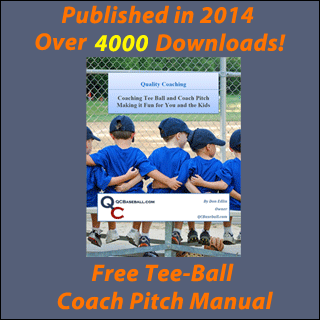Charting Pitchers and Hitters
What's Charting
Charting is a way of tracking different types of information for hitters and pitchers. Charting can be done to analyze a singe at bat, a game, a series of games, or a season. You can think of it as an extension of the score book. When charting your not concerned with statistics that you normally calculate from your score book. What you're interested in is information that you can use to help you coach your players.
Why Chart
I know many coaches and parents who can tell you the batting averages, homeruns, ERA, etc. for everyone on the team. Many coaches spend a lot of their time calculating those stats. What do those stats really tell you? Mostly they tell you what you already know. You know who is hitting the ball well and who is not. You don't need batting average to tell you that. Ask many of those same coaches and parents what the strengths and weaknesses of an individual hitter or pitcher are and you'll find they often have no idea. The focus on stats often takes away from where the focus should be, building skill. Charting allows a coach to analyze performance after the game of individual players and from that come up with a practice plan that attempts to help the player build the necessary skill in areas of weakness.
What Charting Can Tell You
Charting your games or a team scrimmage will give you some valuable information that you can use to work with your players on the mental part of playing baseball. It will help you help them in developing an approach to the game.
When you chart a pitcher, you have the information to go over the game hitter by hitter, pitch by pitch. This will allow to to discuss the approach to each hitter, pitch selection, pitch location and pitch counts. Rather than telling a pitcher that they'll get in trouble more often when they get behind in the count, you'll be able to show them. See pitching strategy for more information.
With a hitter you'll be able to go over the pitch selection during each at bat, approach to each at bat, and situational hitting. See hitting approach for more information.
Charts can be used by players during a game. In between innings a pitcher can go over previous at-bats of the hitters that will be coming to the plate the next inning. This will provide him more information to determine how he will approach those hitters. A hitter can also use the charts to not only determine what a pitcher has done against him up to that point in the game, but how he has pitched to all the hitters.
If you face the same teams multiple times, charts from the previous games can help you prepare for both the pitchers and hitters that your team will face.
Sounds Time Consuming
If it sounds like charting is too time consuming and takes too much effort, you may be right. But, so is keeping stats if you do them yourself. I always have a Dad or Mom who don't want to coach, but come to all the games and like to help out. I put one of them in charge of charting the hitters and another in charge of charting the pitchers. It takes about 10 minutes to show them how to chart.
What Age To Start Charting
Fear of Being Hit - Batter
With younger players, the emphasis is to try and get them to swing the bat and be aggressive at the plate. Their fear of getting hit will often keep the bat sitting on their shoulder. Discussing pitch selection and how to approach different counts will have little to no value for the player. Instead, extra practice correctly getting out of the way of pitched balls will be more beneficial to help the player gain confidence and comfort in the box. Once a player can step in the box and overcome his fear, he will be able focus on an approach. Until then, everything else will be an afterthought.
Attention Level
One of the biggest problems with coaching is the tendancy to over coach. Young players can only process so much input and often our expectations are just too high. If a player doesn't have the attention span to sit down with you and go over the information in the charts, then only use the charts if it benefits you to identify weak areas with a player. You can use this information to help determine appropriate drills to strengthen these areas.
Skill Level
Charting kids that aren't at a certain skill level will be of little value. If a young pitcher only throws a fastball and has little control, then there's no point in charting his pitches. Spend your time working on his mechanics rather than discussing pitch location. The same is true for hitters. If they have flaws in their swing, work those out first.
How to Chart
There are many types of charts that you can purchase. I have created some charts for you to use free of charge. All charts are set up to chart an individual pitcher or hitter. Samples and instructions are provided with each chart.
There are no rules that you have to chart in a certain way or chart all players all the time. Charting is supposed to be a tool to help you, not another responsibility. Those parents may not want to chart each hitter, each inning, of every game. I don't blame them I wouldn't want to either. I don't chart the entire team each game. I have the parent chart only 2 or 3 hitters. I pick 2 or 3 players that seem to be hitting well during practice, but not during the game and chart them. Same for the pitchers. I may have the parent chart one pitcher each game. Again, maybe a pitcher that is throwing strikes, but having trouble getting outs. This gives me a reasonable amount of data to analyze and hopefully determine a coaching action that I can use to try and help the player.
Coaching Advice
If the kids on your team are old enough, have them do the charting. This is a good way to keep them in the game and thinking baseball.
Mental Part of Baseball
You'll often hear coaches telling players that the game of baseball is 90% mental, but how much time is actually spent developing the mental part of the game? If you look back at your practices, you may discover that not much time is spent developing a player's mental approach to the game. As coaches we often enforce this by packing as much repetition into a practice as possible. Often, the goal is to rush through batting practice, trying to get that second round in. What gets lost is the importance of quality in relation to quantity. It would be more beneficial for a player to take 5 good swings with a purpose than to simply hack away at 20 quickly thrown balls. Charting is one tool that you can use to give the player purpose and open up a discussion about the mental part of baseball.
How to Incorporate Into Practice
Here are some ideas on how to incorporate the mental part of baseball into your practices with the aid of charts:
- Share the charts with your players and discuss what they show. This can be done as a group or with individuals. Have them come up with a weakness that they are going to concentrate on during batting practice. When they get up to the plate ask each player what he is working on. If it's hitting the ball the other way, try to throw the ball in a location that he can work on that skill. If he is working on not swinging at bad pitches. Mix in some bad pitches so he can take some that aren't strikes.
- Have a station during batting practice where you sit on the bench with each player once as they rotate through batting practice. Take this opportunity to go over their hitting charts and discuss problem areas and approach at the plate. If a player has a flaw in his swing that want to fix, use the charts to explain how fixing that problem will help. For example, if a player steps in the bucket, the charts should show that the player is having difficulty hitting a pitch on the outside half of the plate. The player may hear you tell him not to step in the bucket, but if he sees he hasn't hit a pitch on the outside part of the plate all season, it may drive home the need to fix the problem.
- If a pitcher isn't going to pitch all the time or is going to have a long time between starts, plan for the pitcher to pitch a mock game in the bullpen. Have a coach or another player chart the mock game. This will force the pitcher to concentrate on situations, mechanics and control rather than just throwing. Always have the pitcher concentrate on mechanics during this mock game. Lack of control by the pitcher is usually related to a flaw in his pitching motion, not lack of concentration.
Coaching Advice
Remember: Always emphasize quality over quantity during all drills. One way to do this is to give them a purpose during the drill. For a pitcher working in a bullpen it may to place his fastball first inside and then outside. See Pitching Accuracy drill for an example. For a hitter it may be to wait on the ball and try to hit it up the middle. See Up the Middle drill for an example.
Most Recent Blog Posts
Working With Players on Focusing on the Correct Part of the Baseball when Hitting (October 15 2016)
Getting More Accurate Throws From Your Team (April 5 2016)
Just wanted to say Thank you for the great website. Great information for this new coach. It sounds like baseball gave a lot to your life, so thanks for giving back to baseball.
- Ray K.







